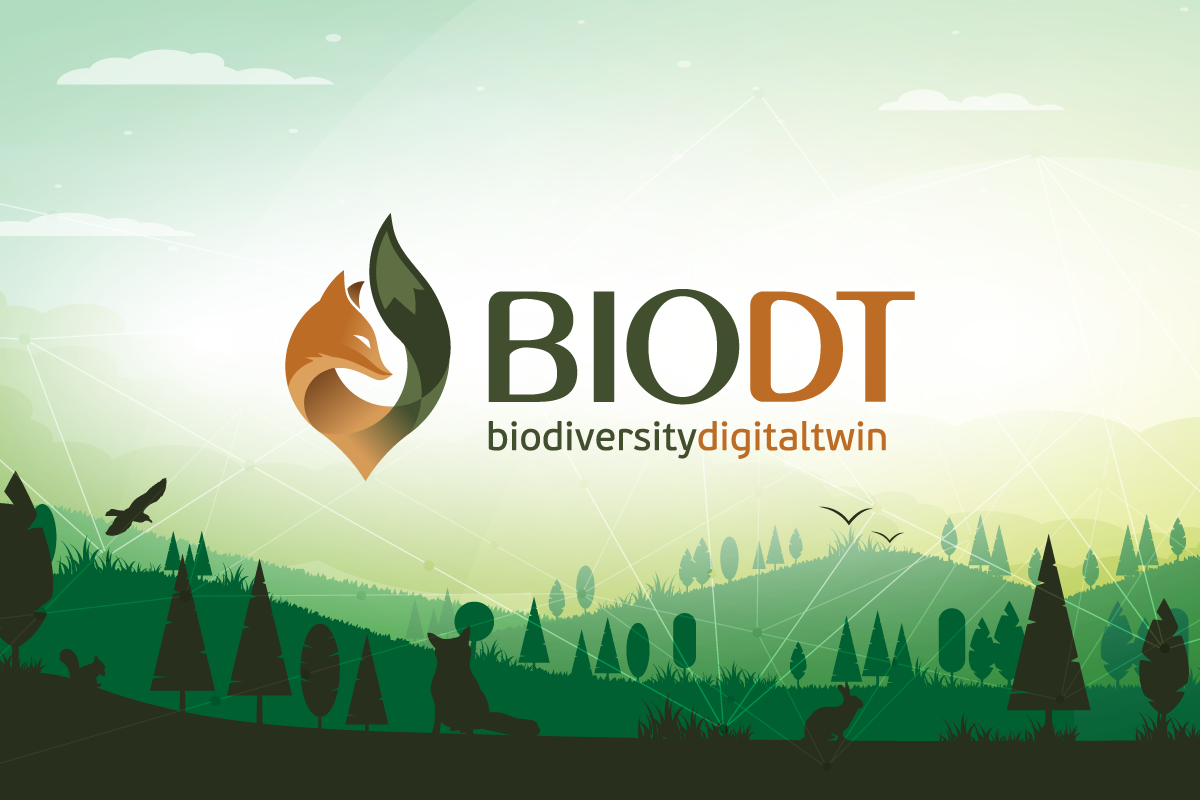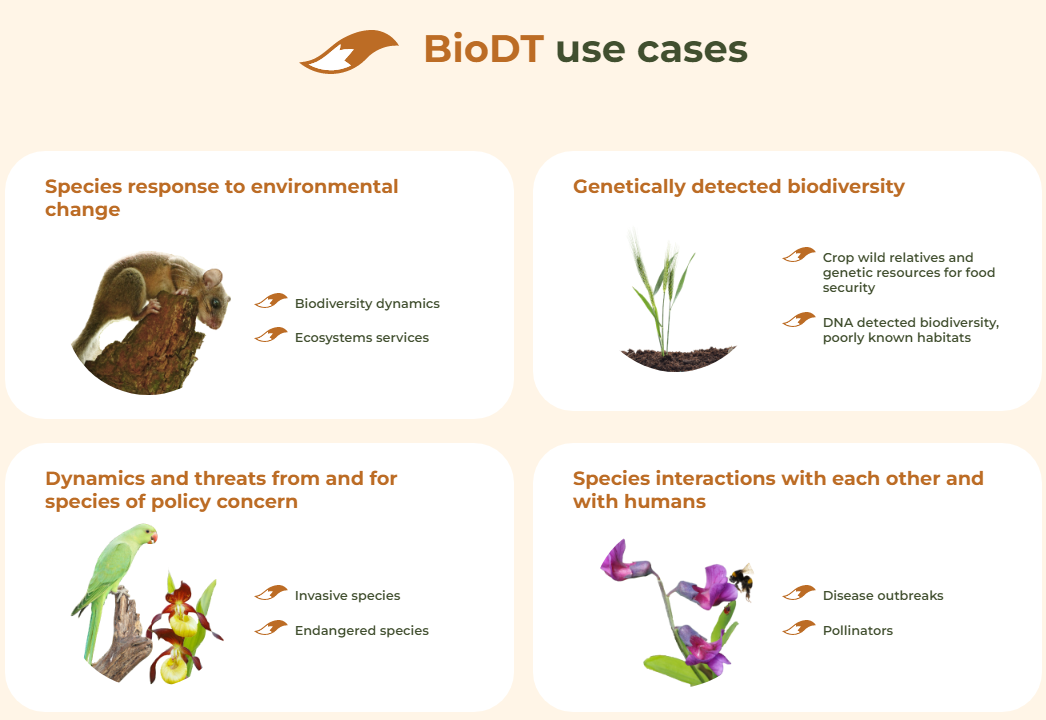
20 June 2022
Top European Research Infrastructures come together to design and develop BioDT, a digital twin prototype for the study and analysis of biodiversity, in support of the EU Biodiversity Strategy for 2030. DiSSCo is, of course, part of this new and challenging endeavour!
Biodiversity provides essential resources and services that we use and that directly impact human wellbeing including food, nutrients, and energy resources, as well as being critical to ecosystem functioning and health. Over 70% of essential medicines and pharmaceuticals are derived from biological sources, and there is mounting evidence that a lack of contact with natural biodiversity impacts the human microbiome with negative health consequences. As our planet faces pressing interconnected challenges, it is fundamental to understand the impacts of climate change and human activities on biodiversity and how their effects can be mitigated and eventually reversed.
In the context of recent efforts supported by the European Commission for the development of digital twins to address multidisciplinary environmental and societal challenges, a consortium led by the Finnish CSC – IT Center for Science, home of the EuroHPC LUMI supercomputer, is taking on the task of designing and developing a digital twin dedicated to biological diversity in the BioDT project.
“CSC is pleased to support this flagship project, with BioDT being one of the first European-wide research initiatives to benefit from access to the LUMI supercomputer”, said Jesse Harrison, BioDT Project Manager. “BioDT will directly improve our ability to address global challenges associated with biodiversity loss and the climate crisis, including the provision of ecosystem services and food security, predicting disease outbreaks, and understanding the dynamics of key species of policy concern.”
Redefining our ability to predict biodiversity dynamics
Understanding the forces shaping biodiversity is needed for rational management of natural resources and also to meet the EU Biodiversity Strategy for 2030 to restore biodiversity in Europe. In particular, researchers need to be able to better predict global biodiversity dynamics and how species interact with their environment and with each other. This can be an extremely difficult task because the processes underlying biodiversity dynamics are complex. Innovative ways to combine data, models and interaction processes are required to predict these dynamics and offer solutions that promote a sustainable management of Earth’s biodiversity and its ecosystems.
The 22-partner strong consortium aims to push the current boundaries of predictive understanding of biodiversity dynamics by developing a Biodiversity Digital Twin (BioDT) providing advanced modelling, simulation and prediction capabilities. By exploiting existing technologies and data from relevant Research Infrastructures in new ways, BioDT will be able to accurately and quantitatively model interactions between species and their environment.
Scientists at involved Research Infrastructures (RIs) will use the BioDT to:
- better observe changes in biodiversity in response to forces resulting from climate change or human activity,
- mechanistically understand how these changes occur,
- predict the effects of these changes.
BioDT will provide a crucial infrastructure to drive long-term biodiversity research and facilitate science-driven policy and rapid-response actions to enforce current commitments to protecting biodiversity in the long term.

Fig. 1: BioDT use cases
Practical examples and societal impact
The project features eight use cases related to land ecosystems, clustered in four groups grounded in the scientific and technical expertise of the consortium. These use cases focus on the species and ecosystems of highest conservation and policy concern, such as threatened species, pollinators, and grasslands, and are vital to mankind’s well-being and biodiversity conservation efforts.
- Group 1 – Species response to environmental change
- Group 2 – Genetically detected biodiversity in cryptic environments
- Group 3 – Dynamics and threats from and for species of policy concern
- Group 4 – Species interactions with each other and with humans
They address global issues of critical societal interest including climate change impacts on species and ecosystems, food security, implementation of EU and international policies and health, and will specifically contribute to addressing the UN Sustainable Development Goals 2 – Zero hunger, 3 – Good health and well-being, 13 – Climate action, and 15 – Life on land.
“Improvements to data standardisation, access and interoperability continue to shape data-intensive modelling and research in biodiversity informatics,” said Joe Miller, GBIF Executive Secretary. “The technological and methodological advances outlined in BioDT will help us to scale up and enhance the quality, speed and relevance of ecological research data to targeted uses in fundamental and applied science.”
Multidisciplinary data for interconnected challenges
BioDT brings together a dynamic team of experts in biodiversity, high-performance computing, artificial intelligence, digital twinning and FAIR data to develop the first BioDT prototype. The scientific expertise and existing datasets from four major biodiversity Research Infrastructures (GBIF, eLTER, DiSSCo, and LifeWatch ERIC) will bring life to BioDT, allowing for coverage of several application domains such as environmental and earth science, climate science, ecology, biology, genomics, natural history, biodiversity informatics, computer sciences, and mathematics / statistics.
BioDT and its infrastructure will become an integral component of the Destination Earth initiative and actively participate in its ambition to realise a full Digital Twin of the Earth. The long-term objectives of BioDT are also tightly interconnected with the EC vision for a robust, federated European computing and data infrastructure, and initiatives such as the European Open Science Cloud (EOSC) and EuroHPC.
The kick-off meeting is scheduled for 14-15 June in Espoo, Finland, involving partners from across Europe in one of the first physical events of the season for many, as the world seeks to emerge from the pandemic, yet another example of how interconnected and multidisciplinary current global challenges are. In the near future, BioDT will be there to support the research community and society at large.
Follow BioDT
Twitter https://twitter.com/BiodiversityDT
LinkedIn https://www.linkedin.com/company/biodt/
YouTube https://www.youtube.com/channel/UCqKjtPwy2Tu9lg2sAx1piIA
Contacts
Jesse Harrison, CSC (Project Manager) jesse.harrison@csc.fi
Federico Drago, Trust-IT Services (Communications Manager) f.drago@trust-itservices.com